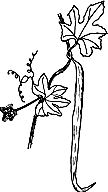View crop
View crop Data sheet EcoPortTrichosanthes cucumerina
 |
|
| Notes |
|---|
| BRIEF DESCRIPTION A climbing herbaceous vine with 40-120 cm long beans. The beans are pale-green and orange when ripe. Single fruits weigh about 0.5-1 kg, and contain 40-70 seeds. One plant of a traditional cultivar may produces 6-10 fruits per year, while improved cultivars may produce up to 50 fruits per year. USES The immature fruit is boild and consumed as a vegetable or in curries. The ripe fruit is fibrous and bitter. Young shoots and leaves are also edible. In West Africa the red fruit pulp is used as a kind of cheap tomato paste. Fruits of the wild forms are very bitter and inedible but used for their medicinal properties. GROWING PERIOD Annual herb, young fruits may be harvested 50-70 days from sowing, continuing to 80-130 days. COMMON NAMES Snake gourd, Club gourd, Courge-serpent, Serpent vegetal, Cohombre vibora, Padwal, Chichinga, Podalangi, Patola, Tomato elejo, Paria belut, Paria ular, Pare welut, Ketola ular, Pakupis, Tabubok, Ngoo ngeewz, Buap ngu, Nom phichit, Ma noi. FURTHER INF Scientific synonyms: T. anguina. Snake gourd is probably native of China and Malaya. The wild species can be found in scrup, along forest edges and in open forest, up to 1000 m or even 1500 m in elevation. It is well adapted to the growing conditions at low elevations in the humid tropics. It does not tolerate dry soils but is also sensitive to waterlogging. Yields may vary between 8-10 t/ha. | Sources |
| SOURCES (T. cucumerina L.) Purseglove J 1974 pp 136-138 [USE] Tindall H 1983 pp 187-189 [TEMP, RAIN, DRA] Duke J 1975 pp 29 [PH, RAIN, TEMP] Roecklein J 1987 pp 502 [USE] Hockings E 1961b pp 424-425 [USE, KTMP, TEXT, DRA, FER] Siemonsma J 1993 pp 271-274 [USE, TEMP, DRA, TEMP, LIG] |